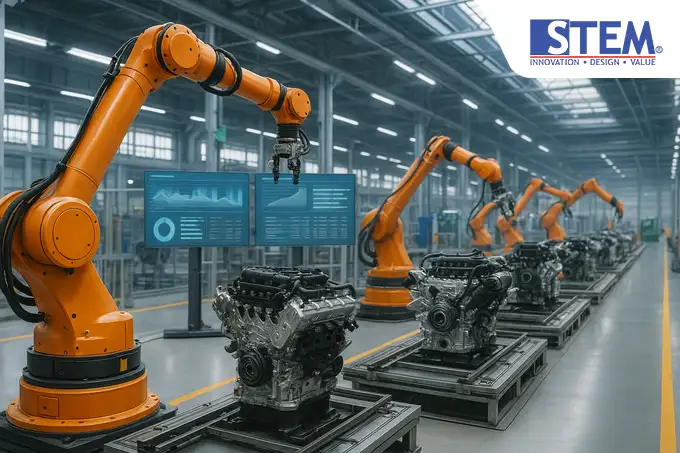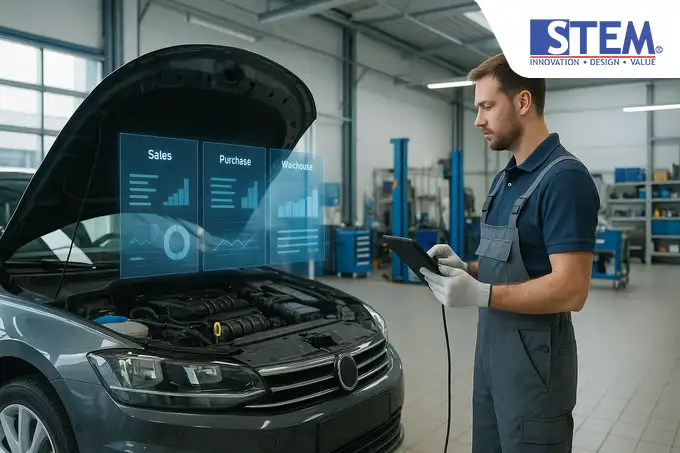The automotive manufacturing industry is an exceptionally intricate ecosystem. Imagine a factory tasked with orchestrating thousands of components from hundreds of diverse suppliers, assembling them with exacting precision, all while adhering to uncompromising international quality standards. Within this labyrinth of operations, data emerges as the most vital asset.
How can a manufacturer ensure the availability of components, keep production costs under control, and track every item from warehouse shelves to the finished product? The answer lies in a reliable ERP (Enterprise Resource Planning) system.
This article serves as your definitive guide to understanding the role of each SAP Business One module for the automotive industry. As one of the leading automotive manufacturing ERP solutions tailored for small and medium-sized enterprises (SMEs), SAP Business One delivers an integrated platform designed to address the industry’s unique challenges.
Let us examine the key modules that make it the preferred solution for players across the automotive sector.
Why Are ERP Modules So Essential in the Automotive Industry?
Before exploring each module in depth, it is crucial to understand why ERP systems are no longer optional, but an absolute necessity for automotive manufacturers. Modern production environments face relentless pressures from multiple directions—pressures that only an integrated system can effectively address.
- Bill of Materials (BOM) Complexity: A single vehicle is composed of thousands of parts, from the tiniest bolt to the engine block. Managing such an intricate BOM manually is inefficient and highly prone to error.
- Just-in-Time (JIT) Manufacturing: To reduce storage costs, many automakers adopt the JIT model, where components arrive precisely when needed. This model demands perfect synchronization between demand, production, and supply—achievable only through a robust automotive ERP system.
- Stringent Quality Regulations: The automotive sector is governed by exacting standards such as ISO/TS 16949. Compliance requires complete traceability of every component and process, from raw material intake to the finished product shipment.
- Dependence on Global Supply Chains: Even a minor disruption at a single supplier across the globe can bring an entire assembly line to a standstill. ERP mitigates these risks by providing complete visibility across the supply chain.
Core SAP Business One Modules for Automotive Manufacturing

SAP Business One (SAP B1) addresses these challenges with a suite of synergistic modules. Below are the five most crucial modules for component suppliers and automotive assemblers.
1. Production & Bill of Materials (BOM)
This module is the beating heart of manufacturing operations. SAP Business One’s Production module empowers companies to define and manage the entire assembly process.
- Bill of Materials (BOM): Think of this as the production “recipe.” For the automotive industry, the SAP B1 automotive BOM may consist of highly complex, multi-level structures. For example, the BOM for a braking system may include sub-BOMs for calipers, discs, and brake pads—each with its own list of components.
- Production Orders: The module manages the lifecycle of production orders—from planning and release to the shop floor, recording material consumption and labor time, through to the completion of finished goods.
- Cost Integration: Every component in the BOM is linked with cost data, enabling the system to automatically calculate both estimated and actual production costs.
2. MRP (Material Requirement Planning)
The MRP module functions as the brain of logistics and procurement planning. Without a solid MRP engine, JIT manufacturing cannot be executed efficiently.
- Material Requirement Calculations: SAP Business One automotive MRP employs advanced algorithms to analyze data from multiple sources: sales orders, demand forecasts, minimum stock levels, and BOM structures.
- Automated Recommendations: Based on these analyses, the MRP Wizard generates actionable recommendations—creating purchase orders for raw materials or production orders for semi-finished goods. This prevents bottlenecks or delays caused by material shortages.
- Vital for OEMs & Suppliers: For spare parts suppliers and Original Equipment Manufacturers (OEMs), this automotive material planning feature is indispensable for meeting fluctuating customer demand on time.
3. Inventory & Warehouse Management
Managing thousands of parts with varying lifecycles poses immense challenges. This module provides complete control over every item within the warehouse.
- Real-time Stock Control: It delivers accurate visibility into stock quantities for both fast-moving and slow-moving items—crucial for automotive inventory management to avoid overstocking that ties up capital.
- Multi-Warehouse Management: Companies can oversee inventory across multiple locations—raw material warehouses, semi-finished goods on the shop floor, and finished goods warehouses—all within a single system.
- Traceability via Barcode/RFID: Integration with scanning technologies enables tracking of batch numbers or serial numbers, vital for identifying component origins should quality issues arise.
4. Quality Management
Quality is the lifeblood of the automotive industry. This module ensures that every product leaving the factory floor meets rigorous standards.
- Quality Inspections: SAP Business One enables manufacturers to establish inspection checkpoints throughout the production cycle—from raw material intake, during assembly, to final pre-shipment checks.
- Traceability for Audits: By recording QC results for each production batch, companies can effortlessly demonstrate compliance with automotive ERP compliance standards such as ISO/TS 16949 during audits.
- Defect & Recall Management: Should defects arise, the system can swiftly trace affected production batches and components, streamlining investigations and simplifying product recall processes if required.
5. Finance & Cost Accounting
Ultimately, all operational activities must be reflected in the company’s financial health. This module offers a comprehensive and detailed view of financial performance.
- Cost of Goods Manufactured (COGM): The SAP Business One automotive costing module automatically consolidates material costs, labor expenses, and factory overheads into each production order, delivering precise COGM calculations for every unit.
- Profitability Analysis: Businesses can evaluate profit and loss reports by product line, customer, or even project. This empowers management to make sharper, more strategic decisions.
- Budget & Expense Control: With centralized cost data, managers can closely monitor actual expenditures against allocated budgets, enabling timely corrective actions where necessary.
The Power of Integration: How Modules Work in Harmony
The true strength of SAP Business One lies in the seamless integration of its modules. Data flows effortlessly across departments, creating a unified single source of truth.
Consider this simplified automotive SAP workflow:
- Sales: The sales team receives an order for 100 brake systems. The order is entered into SAP B1.
- MRP: The MRP Wizard identifies the new demand and automatically calculates the required brake pads, calipers, and other components based on the BOM and current stock.
- Procurement & Production: MRP recommends generating purchase orders for missing components and production orders for assembly.
- Inventory & QC: As raw materials arrive, inventory updates in real time. During production, QC inspectors perform checks at designated control points.
- Delivery & Finance: Once finished goods pass QC, the warehouse team prepares the shipment. The system automatically generates invoices and records the transaction in the accounting journal.
All of this occurs within a single platform—eliminating redundant data entry and delivering end-to-end visibility for management.
Tangible Benefits of SAP Business One Modules for Automotive Manufacturing

The integrated implementation of these modules yields significant automotive SAP Business One benefits:
- Efficient Production Planning: Achieve more accurate and realistic production schedules.
- Minimized Stockout & Overstock Risks: Optimize inventory levels to sustain smooth production without tying up excess capital.
- Enhanced Cost Control: Accurate cost visibility helps uncover inefficiencies and reduce waste.
- Improved Quality & Compliance: Simplified tracking and auditing ensure adherence to industry standards.
- Business Scalability: A solid ERP backbone paves the way for growth, including expansion into new facilities.
Real-World Case Studies
To provide greater clarity, here are practical examples of SAP Business One automotive case studies:
Case A: Two-Wheeler Component Supplier
A company supplying wheels and tires to major motorcycle manufacturers struggled with long procurement lead times.
After implementing the MRP module, they could forecast material requirements with far greater precision.
As a result, procurement lead time was reduced by 30%, enabling them to respond to customer orders much faster.
Case B: Automotive Interior Component Manufacturer
A factory producing dashboards and door panels faced client demands for full quality assurance and traceability.
With the combined use of Quality Management and barcode-enabled Warehouse Management, they successfully traced every batch of plastic resin from suppliers to the finished dashboard.
This not only enhanced client confidence but also simplified their annual ISO audit process.
Frequently Asked Questions (FAQs)
What are the most essential SAP Business One modules for the automotive industry?
The core modules include Production (with Bill of Materials), MRP (Material Requirement Planning), Inventory & Warehouse Management, Quality Management, and Finance & Cost Accounting.
How does MRP in SAP Business One support automotive manufacturing?
MRP automatically calculates the exact quantity and timing for ordering raw materials or starting component production. This keeps assembly lines running smoothly, prevents stockouts, and supports Just-in-Time (JIT) production strategies.
Can SAP Business One be used by small-scale automotive spare parts suppliers?
Yes. SAP Business One is specifically designed for SMEs, making it an ideal choice for parts suppliers who require strong control over inventory, sales, and finance without the heavy complexity of large-scale ERP systems.
Which module is most critical for automotive quality control?
The Quality Management module plays the central role. However, it integrates closely with Inventory Management (for batch/serial number tracking) and Production (for defining inspection checkpoints) to build a comprehensive quality control system.
Can SAP Business One modules be integrated with MES or IoT sensors?
Yes, SAP Business One offers open architecture and APIs that allow seamless integration with third-party systems, including Manufacturing Execution Systems (MES) and IoT platforms, enabling real-time machine data capture.
Ready to Optimize Your Automotive Plant?
Understanding each module is the first step. The next is tailoring these solutions to meet the unique needs of your factory.
If you are seeking to elevate your automotive manufacturing operations with enhanced visibility, efficiency, and control, we are ready to assist.
Contact Sterling Team (STEM), experienced automotive SAP Business One consultants, to schedule a free SAP B1 automotive demo. Our team will demonstrate firsthand how each module can address your company’s specific challenges.
For businesses with distribution or retail networks, we also provide integrated iReap ERP solutions that streamline operations from the factory to the end consumer.
Request Your SAP Business One Automotive Manufacturing Demo Here!


